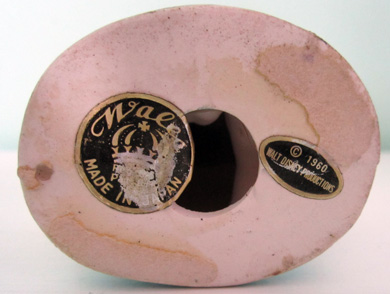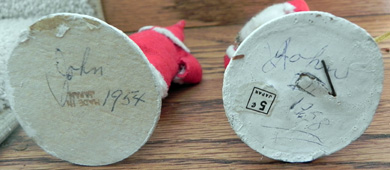 |
|
|||
 |
 |
|||
Copyright © Harry Rinker, LLC 2015 Questions
and Answers
ANSWER: Walt Disney Productions produced its “Alice in Wonderland” film, the 13th Disney animated feature, in 1951. The film was inspired by Lewis Carroll’s Alice books. “Alice in Wonderland” premiered on July 26 in New York City and London. Kathryn Beaumont voiced Alice. The comedian Ed Wynn voiced the Mad Hatter. Disney first attempted a cartoon version in the 1930s. The idea was revived in the 1940s and slated to be a live-animation film. In 1946, Walt Disney decided to limit the film to animation. Initially the film failed at the box office. Critics panned it. The film was never re-released in Disney’s lifetime. It occasionally appeared on national television. The success of George Dunning’s animated “Yellow Submarine” in 1968, caused film devotees to take another look at “Alice in Wonderland.” Today, “Alice in Wonderland” is a cult classic. Disney Productions were skilled marketers. The box office failure of “Alice in Wonderland” deterred the licensing process. Historically, licensing rights were sold after a film was released and proved a success. It was not until the late 1970s that Disney and other production companies recognized the marketing advantages associated with having toys on store shelves prior to or upon the release of a movie. [Author’s Note: When “Star Wars: Episode 4 – A New Hope” was released in 1977, there were no Star War toys in toy stores. Lucas corrected this immediately.] Your “Alice in Wonderland” figure is copyrighted 1960. It most likely was licensed as a result of the film’s appearance on television. I researched “Alice in Wonderland” memorabilia to see if additional figures were made at the same time as your Alice figurine. I found two examples of your Alice figurine on eBay – one with a Cheshire Cat figurine and the other with a White Rabbit figurine. The Cheshire Cat and White Rabbit figurines appear to be from the same time period.
The survival rate of your Alice figurine is very high. Examples are readily available on the internet for prices ranging between $10.00 and $12.00. I favor a slightly higher price for your figurine because the two bottom decals remain attached. QUESTION: My husband acquired two Santa Claus Christmas ornaments as a toddler. One measures 4 inches and the other slightly over 3 1/2 inches. Both are dressed in red felt coats. The base of the first is marked “John / MADE IN JAPAN / 1954.” The base of the second is marked “John / 5 ¢ JAPAN [applied paper label] / 1958.” There is damage to the feet of the first Santa, and the second Santa has lost part of his left arm. What are these adorable Santas worth? -- SS, Bozman, MT, Email Question
ANSWER: Your query was fun to research. The initial assumption is that the dates on the figures when John received them correspond with the date the figurines were made. However, when I researched 1950s Santa Christmas ornaments, the examples I found were different. The ornaments given to John more closely represent 1930s Japanese Santa ornaments than they do examples from the 1950s. Is it possible your husband may have received older ornaments from a grandparent, aunt, or uncle? As a toddler, I assume he has no memories of how he acquired the ornaments. By the mid-1950s, Japan was in full recovery from the devastating impact on its economy from World War II. Further, this was the great age of plastic. My mid-1950s Santa figurine memories are of plastic Santas on skis, in a sleigh, or standing upright with a pack on his back. I haunted the local five and dimes. I do not remember this type of Santa ornament. But, who remembers everything? If the ornaments date from 1945 to early 1952, the basic assumption is that they would have been marked “Made in Occupied Japan.” America occupied Japan from August 1945 to April 28, 1952. Goods made in Japan for export were usually marked “Made in Occupied Japan” or “Occupied Japan.” However, some goods made during the occupation period, especially toward its end, were marked “Japan” or “Made in Japan.” “Made in Japan” was the correct 1954 marking.
Whether made in the 1930s or 1950s, the difficulty is the damage to the ornaments, especially the example missing a portion of the arm. The ornaments’ primary value is your husband’s memories. In terms of antiques and collectibles secondary market value, each is valued between $4.00 and $6.00. QUESTION: I have a baby grand piano manufactured by Hazelton Brothers. My father acquired it new in the 1930s. I do not play piano. I want to sell it. Although the piano has not been tuned for decades, it sounds fine. What advice can you provide? – C, Reading, PA ANSWER: Henry and Fredrick Hazelton established F & H Hazleton located in New York City in 1840. When a third brother John jointed the firm, it was renamed Hazelton Brothers Piano Company. During the nineteenth century, the firm manufactured baby grand pianos, square grand pianos, and upright pianos. Production of square grand pianos ended in the 1890s. Player pianos and reproducing grand pianos joined the product line after the turn of the twentieth century. Although surviving the Great Depression, the firm ended production in the late 1950s. Samick of Korea, a piano importer, manufactures pianos using the Hazelton Brothers brand name. See: http://antiquepianoshop.com/online-museum/hazelton-brothers/. There are two key concerns regarding your piano. First, it has not been played or tuned for decades. While the instrument may sound fine to you, it may not to an expert. The correct grade condition for your piano is “playable, but not restored.” One option is to pay a piano tuner to tune the piano and assess its tone. Another is to sell the piano as it, letting the buyer decide if he/she wants to tune, assess, and, if need be, restore the piano. I favor this approach. Second, the cost to have a baby grand professionally moved is between $500.00 and $750.00. A potential buyer is going to consider this when evaluating the asking price. If the piano was an upright, I would suggest trying to find a group of individuals willing to move the piano for a case of beer and pizza. Baby grand pianos require a professional moving surface. Determining an asking value for your Hazelton Brothers baby grand piano requires working backwards. The standard asking price for a restored 1920s/1930s baby grand is between $3,000.00 and $4,000.00 dollars. There currently is an example on eBay that falls within this price range. If you want to sell your piano quickly, you need to set an asking price considerably below these values. Given you piano’s condition, I recommend between $1,000.00 and $1,500.00. There are several sales avenues open to you. Craigslist is the most obvious. List it at “Best Offer Above $1,000.” Contact local piano dealers and see what interest they might have. Do not be surprised if they offer to take it on consignment rather than make a cash offer. Spread the word among friends and organizations to which you below. This is a far more effective sales approach than most realize. Auction is not a viable sales avenue. Baby grand pianos often sell for under $500.00 in this venue. QUESTION: I own a battery operated Charlie Weaver: Bartender toy. The box is missing. I took the toy apart and completely restored it. Smoke emanates from the toy as it did originally. What is my Charlie Weaver: Bartender toy worth? – Don, Lincoln City, OR ANSWER: Clifford Charles “Cliff” Arquette (1905-1974), comedian and radio personality, created the character of Charlie Weaver. In the 1930s, he created a rubber theatrical prosthetic mask that allowed air to reach an actor’s skin but also mimicked changing facial expressions. Although the Charlie Weaver character was established during his radio career, Arquette’s big break came when he did a 1959 guest appearance on NBC’s “The Tonight Show,” hosted by Jack Parr. Charlie Weaver was introduced as the “Wild old Man from Mount Idy.” I watched many Charlie Weaver performances on “The Tonight Show.” Individuals from the next generation remember Cliff Arquette’s Charlie Weaver from “Hollywood Squares,” where he occupied the lower left square. See: https://en.wikipedia.org/wiki/Cliff_Arquette. The standard asking price for the 1962 Charlie Weaver Bartender battery operated toy on eBay ranges from $35.00 to $45.00. If the period box accompanies the toy, the value triples. The toy is extremely common. [Author’s Aside: Cliff Arquette also was a historian. He created the Charlie Weaver Museum of the Civil War in the building that served as the headquarters for the Union General O. O. Howard during the Battle of Gettysburg and later as an orphanage for the children of Civil War soldiers. The museum eventually became the Soldiers National Museum. Its contents were sold at auction in November 2014.]Harry L. Rinker welcomes questions from readers about
collectibles, those mass-produced items from the twentieth and twenty-first centuries.
Selected letters will be answered in this column.
Harry cannot provide personal answers.
Photos and other material submitted cannot be
returned.
Send your questions to: Rinker on Collectibles, 5955 Mill
Point Court SE, Kentwood, MI 49512.
You also can e-mail your questions to
harrylrinker@aol.com.
Only e-mails containing a full name and mailing address
will be considered.
You can listen
and participate in
WHATCHA GOT?, Harry’s
antiques and collectibles radio call-in show, on Sunday mornings between 8:00 AM
and 10:00 AM Eastern Time.
If you
cannot find it on a station in your area,
WHATCHA GOT?
streams live on the Internet at www.gcnlive.com.
SELL, KEEP OR TOSS?: HOW TO DOWNSIZE A HOME,
SETTLE AN ESTATE, AND APPRAISE PERSONAL PROPERTY
(House of Collectibles, an imprint of Random House Information Group, $17.99),
Harry’s latest book, is available at your favorite bookstore and via
www.harryrinker.com.
|
||||
 QUESTION: I have a small Alice in Wonderland ceramic figurine. It stands 5 ¼ inch high. The bottom has two labels. The round label reads “Wales / Made in Japan” with a crown in the center. The oval label reads “© / WALT DISNEY PRODUCTIONS / 1960.”Any information you can furnish would be appreciated. – R, Parryville, PA, Email Question.
QUESTION: I have a small Alice in Wonderland ceramic figurine. It stands 5 ¼ inch high. The bottom has two labels. The round label reads “Wales / Made in Japan” with a crown in the center. The oval label reads “© / WALT DISNEY PRODUCTIONS / 1960.”Any information you can furnish would be appreciated. – R, Parryville, PA, Email Question.

